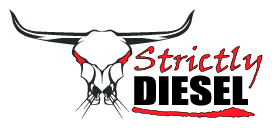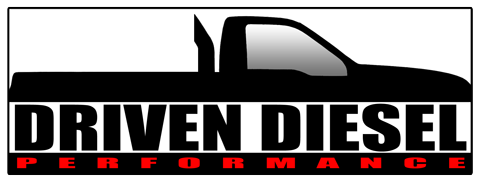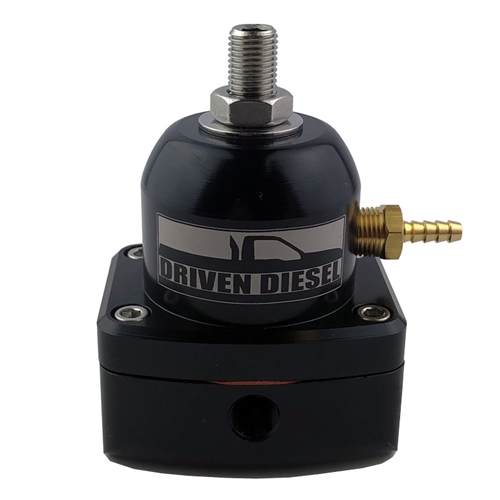 After nearly 20 years of building and selling custom fuel systems for 7.3L and 6.0L Powerstroke Diesels, it's pretty safe to say that I've done my fair share of troubleshooting. Probably the most common statement from truck owners that are experiencing some kind of issue with their fuel system is "I think the regulator is bad" or "I need to buy a new regulator". When I ask what kind of problem they are having, it is always some version of "the pressure is too low". I've lost track of how many fuel pressure regulators I've sold from both Aeromotive and Fuelab over the years, but I can count on one hand the number of times that we had an actual regulator functionality problem, and I will still have fingers left over.
After nearly 20 years of building and selling custom fuel systems for 7.3L and 6.0L Powerstroke Diesels, it's pretty safe to say that I've done my fair share of troubleshooting. Probably the most common statement from truck owners that are experiencing some kind of issue with their fuel system is "I think the regulator is bad" or "I need to buy a new regulator". When I ask what kind of problem they are having, it is always some version of "the pressure is too low". I've lost track of how many fuel pressure regulators I've sold from both Aeromotive and Fuelab over the years, but I can count on one hand the number of times that we had an actual regulator functionality problem, and I will still have fingers left over.Bypass Fuel Pressure Regulators are actually extremely simple devices. I regularly tell customers that think they have a regulator problem to "take it apart and look". There are very few parts, and as long as you pay attention to how they were oriented during disassembly, putting them back together and having them work properly is not all that challenging. Below you will find some images of a Fuelab Bypass Fuel Pressure Regulator that I have disassembled. One shows the internal parts laid out so you can see them, the other shows those same parts correctly oriented for reassembly.
The second most common comment I have made to customers over the years has been, "if you don't have fuel leaking from the brass nipple, the regulator is working". The single most common issue with one of these Bypass Fuel Pressure Regulators is Diaphragm Failure, and even that isn't very common. This always comes in the form of a hole or tear in the flexible portion, and always includes a steady stream of fuel leaking from the brass nipple (boost reference port) in the top half of the regulator. This is why our fuel systems include a length of poly tubing, if the diaphragm fails, we don't want fuel spraying all over the engine. If you have fuel leaking from the boost reference port, you just need a diaphragm. If not, you've got another issue.
Lets take a quick look at how the regulator works.
The base of the regulator has 3 ports. The side ports are plumbed to become part of the "fuel rail" in our Powerstroke trucks. Fuel that passes through the rails in the heads is then directed to each of the side ports in the regulator. In the center of the base of the regulator you will see a seat that leads to the return port on the bottom. The diaphragm has a ball that sits in and seals against that seat. When the pressure coming from the side ports reaches the set point of the adjustable regulator, it lifts the ball off the seat and fuel exits the bottom port of the regulator and returns to the tank. The varying level of flow that is directed back to the tank is what controls the fuel pressure. If the flow coming into the regulator drops (because the injectors are spraying more fuel under heavy throttle...for example), the diaphragm will close against the base of the regulator to maintain the correct pressure. If the flow increases (because you lifted off the throttle), the diaphragm will open and let more fuel return to the tank to continue to maintain the correct pressure. This happens very quickly and smoothly, such that even with a gauge in the cab, you rarely see the needle move as the situation changes. The spring and adjuster screw on the top of the regulator are used to set the pressure required to lift the diaphragm off the seat. As long as all of the parts are still in the regulator, in the correct order and orientation, and you don't have fuel leaking from the boost reference port, the regulator will be operating as designed.
I have seen people online suggest to someone having a problem that "maybe the spring is broken". I have never seen a broken spring in a bypass fuel pressure regulator from either Aeromotive or Fuelab. Anything is possible, but this is extremely unlikely, and easily verifiable by simply taking the regulator apart.
So why is your pressure low?
Consider what I wrote above about how these regulators function. The key to diagnosing a "low fuel pressure" situation is understanding that in order to have "pressure", you must have adequate "flow" AT THE REGULATOR. If your fuel "flow" is reduced for some reason, it can lead to the pressure being lower than desired. There are a number of things that can lead to a decrease in flow. The pump may be old and getting weak, you could have a voltage issue slowing the pump down, there could be a blockage in the suction line from the pump back to the tank or if your pressure problem is only under heavy throttle, your pump may just not be large enough for the injectors and tuning you have in the truck. Since we are just discussing the regulator here, I will address the different methods of diagnosing pressure problems in a different article.
Hopefully the information above and images below will help you to understand how your regulator works, and give you the confidence to open one up and check it out if you think you are having a problem. Generally speaking, these regulators need no maintenance. If the diaphragm fails, replace it and keep on going. If one of the fittings leaks, just replace the o-ring. Should you have a reason to take it apart, just clean it and make sure there is no debris inside before you put it back together.
0psi but the Pump is Running!
If you are showing 0psi on the gauge with the pump running, and you have turned the Regulator Adjuster Screw clockwise until it stops but the pressure never changes, there is a high probability that hoses at the regulator are incorrectly connected. Before going through a bunch of other diagnostic procedures, make sure that the regulator hoses are connected where they should be. The side ports on the regulator should be connected to the hoses coming from the cylinder heads, and the bottom port should be connected to the hose that goes back to the fuel tank.
There are two situations that we have seen cause the 0psi problem. First, the installer has swapped the FUEL SUPPLY and the FUEL RETURN hoses (typically on a Bowl Delete setup). If you connect the Fuel Supply from the pump to the bottom of the fuel pressure regulator, and connect the Fuel Return line to the bowl delete distribution block, you will have ZERO pressure (because the fuel is flowing in the wrong direction). Second, the installer swapped a CYLINDER HEAD RETURN line and the REGULATOR RETURN line. If you connect a Cylinder Head Return line to the bottom port of the regulator, and the Regulator Return line to one of the side ports on the regulator, you will have ZERO pressure (because the return to tank is connected to the fuel supply without a diaphragm between them).
Once you have verified that the connections at the regulator are in the correct locations, proceed with other diagnostic steps if needed.
Check us out for all of your 7.3L and 6.0L fuel system needs. We've got products to fit every need, and the experience and knowledge to back them up.
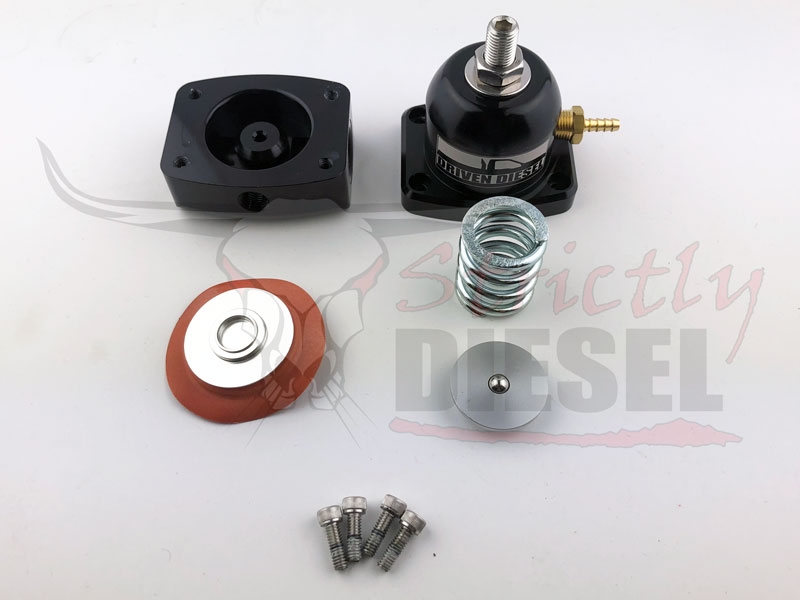
Top Left: Regulator Base
Middle Left: Regulator Diaphragm
Top Right: Regulator Top with Adjuster Screw
Middle Right: Regulator Spring and Spring Cap
Bottom: Regulator Body Screws
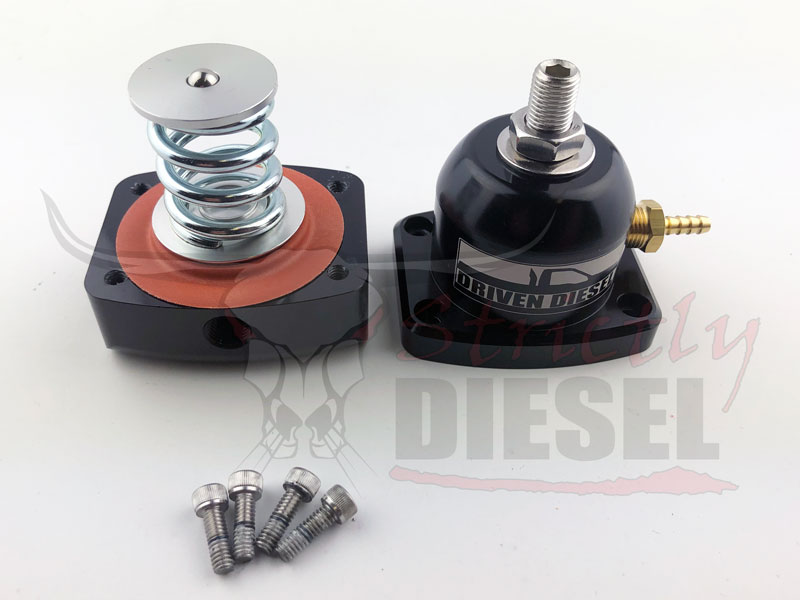
Orientation of Parts in Fuelab Bypass Pressure Regulator

Author: Dennis Schroeder - Co-Owner of Strictly Diesel
Dennis has been Designing, Building and Supporting Aftermarket Fuel Systems for 7.3L and 6.0L Powerstrokes since 2001.
